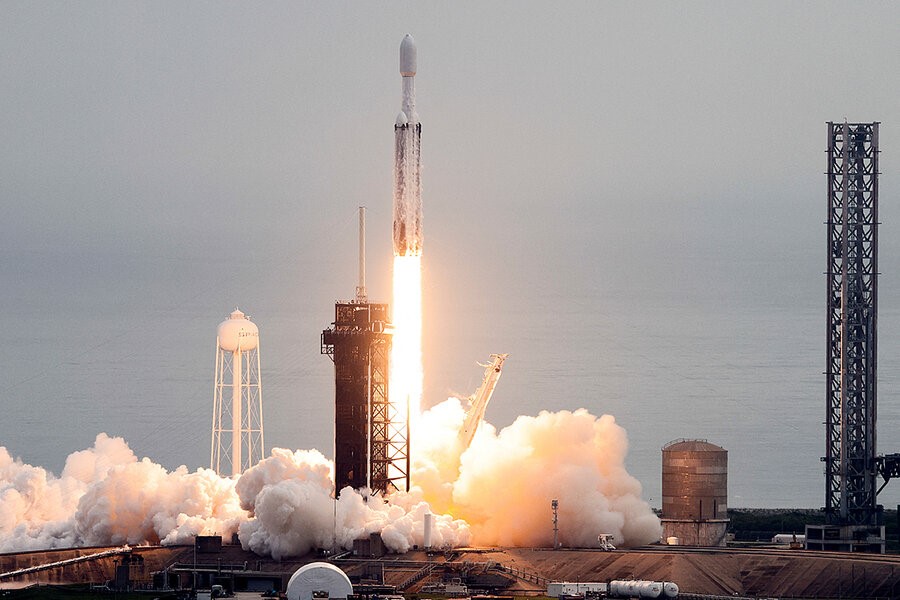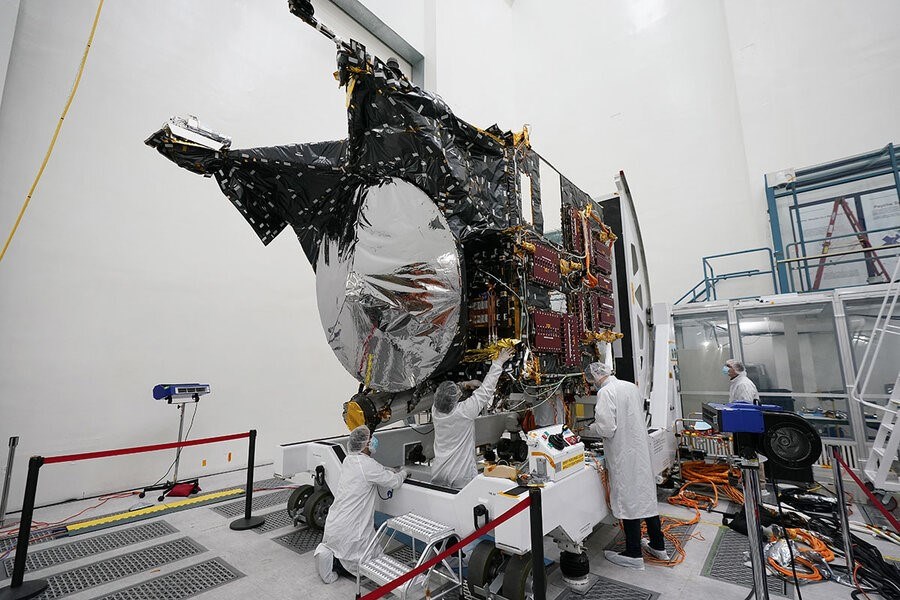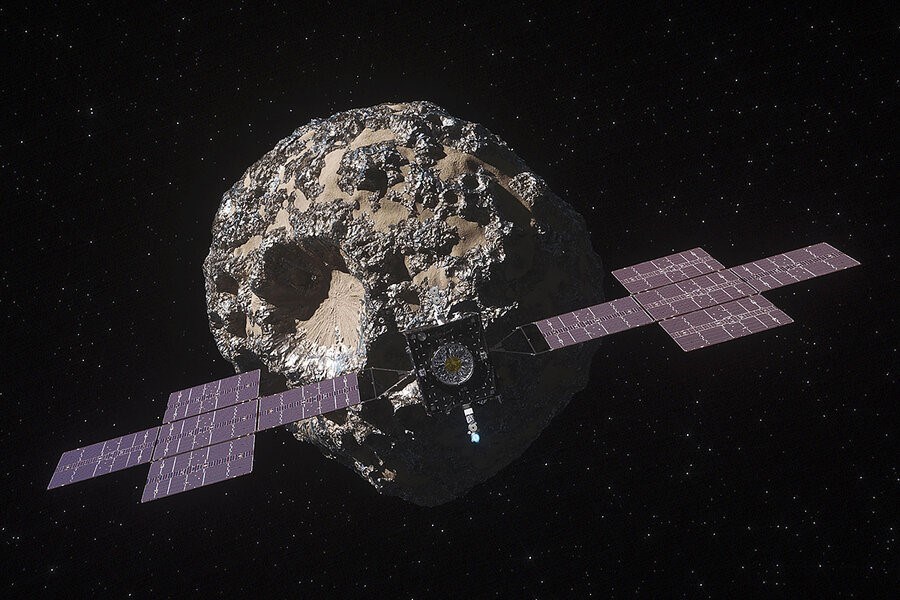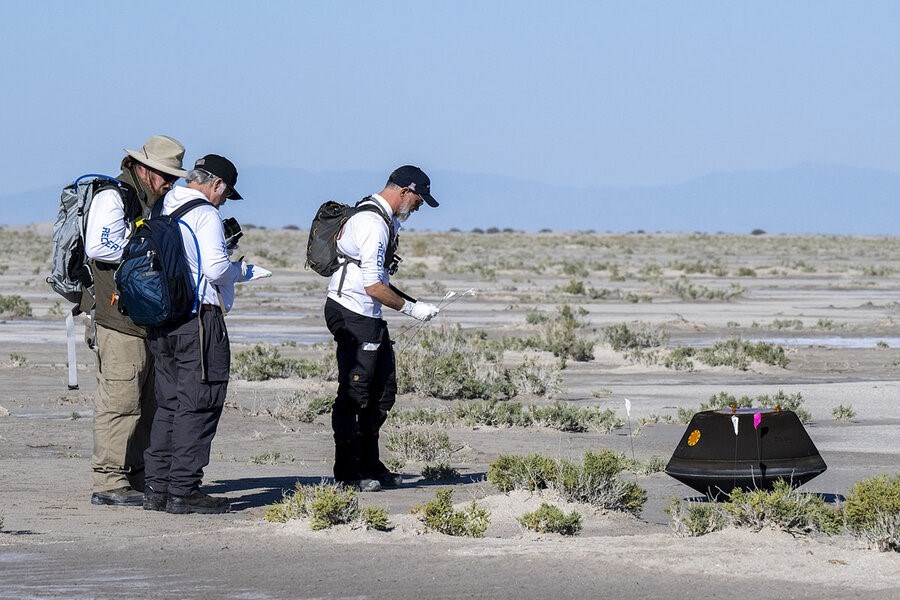REPRINTED WITH PERMISSION FROM THE CHRISTIAN SCIENCE MONITOR
By sending a spacecraft on a journey of 2 billion miles, scientists hope to learn something about the core of our own planet. NASA’s mission to a metal-rich asteroid is about curiosity and creativity.
 A SpaceX Falcon Heavy rocket lifts off carrying a NASA spacecraft to investigate the Psyche asteroid from the Kennedy Space Center in Cape Canaveral, Florida, Oct. 13, 2023. Joe Skipper/Reuters
A SpaceX Falcon Heavy rocket lifts off carrying a NASA spacecraft to investigate the Psyche asteroid from the Kennedy Space Center in Cape Canaveral, Florida, Oct. 13, 2023. Joe Skipper/Reuters
It is a world unlike any yet explored by humankind. No spacecraft, no probe of any kind, has ventured close to anything like this – a large asteroid believed to be made almost entirely of metal.
Now NASA is on the way there.
After a successful launch today, a space probe will begin a six-year journey to an asteroid called Psyche that could open new windows into everything from the formation of planets like Earth to the prospect of mining in space.
At a time when asteroids are a rising focus for space exploration, the Psyche mission is remarkable in several ways. It will pioneer the use of laser signals to send information back to Earth. The craft’s thrusters are also innovative, using a solar-powered electric field to amplify the propellant’s force.
But most compelling is the target itself. Residing in the asteroid belt between the orbits of Mars and Jupiter, Psyche has a 64,000-square-mile surface area about the size of Florida, the state from which the launch occurred. One tantalizing possibility is that the asteroid offers an unprecedented opportunity to directly glimpse the remnant of a small planet core – in this case, one that failed to fully form. But ultimately the current mission, scientists say, must unlock Psyche’s secrets.
“The thing that excites us most about this is that we really don’t know what Psyche is,” says Ben Weiss of the Massachusetts Institute of Technology, deputy principal investigator and magnetometry investigation lead on the Psyche mission. “In our standard view, the one we think is most likely, it’s already very strange compared to anything we’ve sent a spacecraft to – and if it’s not that thing, then it’s even stranger than we’ve imagined.”
 Marcio Jose Sanchez/AP/FileTechnicians work on the Psyche spacecraft at the NASA Jet Propulsion Laboratory, April 11, 2022, in Pasadena, California.
Marcio Jose Sanchez/AP/FileTechnicians work on the Psyche spacecraft at the NASA Jet Propulsion Laboratory, April 11, 2022, in Pasadena, California.Psyche is the largest of a rare breed of asteroids – those that are metal-rich, known as M-types. This one may be heavy on iron and nickel.
The only other place we know of in our solar system where these metals are thought to be found in such density and in such quantities is in the core of rocky planets – Earth, Mars, Mercury, and Venus. Earth’s core, for example, is believed to be solid iron and nickel, making up 20% of the planet’s radius.
Hence one hypothesis has been that Psyche is, in fact, the exposed core of an early planet, a baby planet, or a protoplanet. In the birthing of the solar system, the outer layers would have been ripped off through collisions, leaving the asteroid of today. Estimates of Psyche’s density – it is much lighter than a pure iron-nickel ball would be – have raised doubts about this theory. But scientists see various ways the mission’s learning about Psyche’s composition could shed light on the formative stages of our solar system.
“You know, it’s almost like a fingerprint to what the processes were, happening back then,” says Alan Fitzsimmons, professor of astronomy at Queen’s University Belfast. “It’ll give us a better understanding of the overall history of the solar system and what’s happened over 4 billion years.”
Observing even remnants of a baby planet’s core would be pathbreaking. The limitations of today’s technology mean that direct analysis of our own planet’s core, which sits less than 2,000 miles below us, is impossible. Yet sending a spacecraft on a journey of some 2.2 billion miles to this metallic outpost in space is perfectly feasible.
 NASA/JPL-Caltech/ASUThis illustration, updated in April 2022, depicts NASA's Psyche spacecraft. The Psyche mission will explore a metal-rich asteroid of the same name.
NASA/JPL-Caltech/ASUThis illustration, updated in April 2022, depicts NASA's Psyche spacecraft. The Psyche mission will explore a metal-rich asteroid of the same name.
Starting in 2029, the spacecraft will spend about two years orbiting and gathering data about Psyche – its composition, variations in its gravity, and more. If Dr. Weiss’ efforts detect relics of a magnetic field, that could be a marker of a former planetary core.
If Psyche really is a largely metallic world, its appearance will be revealing. What do its craters – the scars of collisions inflicted over billions of years – look like? Will there be evidence of past tectonic and volcanic processes on such a world?
To assist with this, the Psyche spacecraft will be equipped with three main instruments: a magnetometer to study any magnetic fields, an imager to take pictures, and a gamma-ray and neutron spectrometer to measure the asteroid’s elemental composition.
But there is another piece of technology that’s piggybacking on the Psyche spacecraft, one that has nothing to do with the primary mission of analyzing the asteroid. It is a cutting-edge communications device, one that uses lasers instead of traditional radio waves, and this will be the first time it’s ever been tested in deep space.
DSOC, as it’s called – Deep Space Optical Communications – will enable transmissions at 10 to 100 times the bandwidth of current radio systems. Its creators have an eye toward future missions, not least those that seek to carry astronauts to places where humans have yet to set foot.
“If you build a spacecraft that goes to Mars, you need to base the spacecraft on very reliable technology,” says Clemens Heese, head of the Optical Technologies Section at the European Space Agency. “You’re not likely to take risks [on] things that haven’t been validated, so you fall back on solutions that have been flown before.”
The Psyche launch is just part of a wider growth of asteroid exploration, including NASA’s OSIRIS-REx mission, which recently returned a sample to Earth from asteroid Bennu. The sample was dropped off by a spacecraft as it careened past Earth en route to its second objective, another asteroid named Apophis.
 Keegan Barber/NASA/APScientists collect data next to a sample return capsule from NASA's OSIRIS-REx mission after it landed at the Defense Department's Utah Test and Training Range on Sept. 24, 2023. The sample was collected from the asteroid Bennu in October 2020.
Keegan Barber/NASA/APScientists collect data next to a sample return capsule from NASA's OSIRIS-REx mission after it landed at the Defense Department's Utah Test and Training Range on Sept. 24, 2023. The sample was collected from the asteroid Bennu in October 2020.
Earlier this week, NASA Administrator Bill Nelson said the rocks and dust in the sample contain water and a high percentage of carbon. This is in line with scientists’ theories that asteroids may have brought the building blocks of life to Earth.
Last year, NASA also sent a spacecraft hurtling into the asteroid Dimorphos, marking the first time humanity has intentionally altered the motion of a celestial body. That DART mission (Double Asteroid Redirection Test) reflects the quest for ways to deflect any asteroids that may threaten catastrophic collisions with our own planet.
“If we’ve got missions to the moon, and to Jupiter, why are there still some missions that have an interest in studying asteroids?” asks Queenie Chan, a planetary scientist at Royal Holloway, University of London, whose research focuses on meteorites and asteroids. “That’s because asteroids, we think, are the building blocks of planets. ... So through the studying of asteroids, it helps us understand all these depths of planetary formation, answering where we’re from, the origin of our solar system, the origin of our planets.”
Another driver is something that lies far deeper in the future: the prospect of mining asteroids. While some argue that the costs will always be prohibitive, the riches on offer (Psyche, for example, has been estimated to be worth as much as $10 quintillion) are difficult to ignore.
Indeed, most analysts agree that, at some point, our technological progression, coupled with the industrialization of space, will make mining asteroids a feasible endeavor – not just for metals to haul back to Earth, but also for resources that facilitate space exploration (things like oxygen and ice).
Beneath all of this, there lies another driving force: simple curiosity.
“Humanity has always been that species that wondered what’s over that next hill, and this is just an example where the hills are a bit further away than normal,” says Professor Fitzsimmons of Queen’s University. “We want to know about where we live and how it got to the state it’s in, so that exploration is something that really drives all the scientists and engineers on these missions, I believe.”
Page created on 10/16/2023 10:05:16 AM
Last edited 11/1/2023 5:10:35 PM
